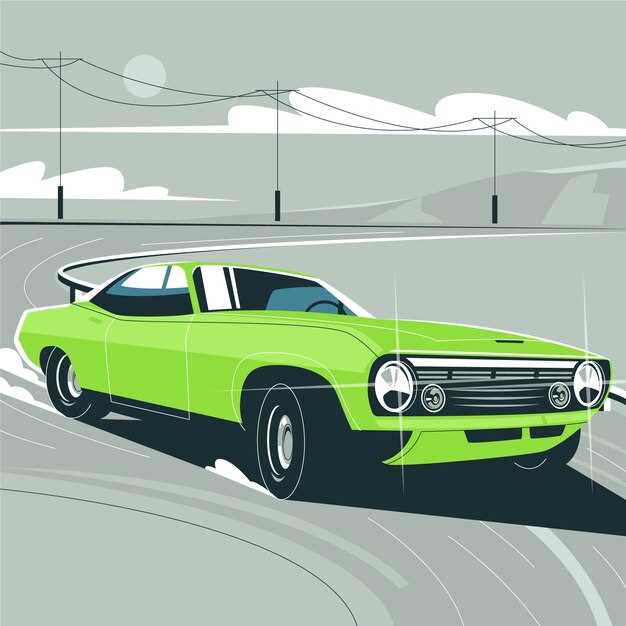
Muscle cars have held a prominent place in automotive culture, symbolizing raw power, distinctive designs, and thrilling driving experiences. In recent years, manufacturers have responded to the growing demand for high-performance vehicles by introducing modern iterations that blend classic muscle with advanced technology and engineering. This article explores the top modern muscle cars currently available in the market, showcasing their standout features, performance capabilities, and overall appeal.
As enthusiasts seek out vehicles that not only deliver on speed and handling but also embody the spirit of American automotive heritage, a diverse range of options has emerged. From revamped classics to cutting-edge designs, these modern muscle cars offer something for everyone. Whether you’re a long-time fan of the genre or a newcomer looking to enter the world of performance driving, there’s a perfect option waiting for you.
In this guide, we highlight the best models available today, focusing on their specifications, innovations, and unique characteristics that set them apart. Join us as we delve into the thrilling realm of modern muscle cars and discover which ones reign at the top of the performance ladder.
Understanding the Key Features of Muscle Cars
Muscle cars are a unique blend of power, performance, and design, characterized by several distinct features that set them apart from other vehicles. At the core of their appeal is a powerful engine, typically a V8, that delivers high horsepower and torque. This engine configuration not only facilitates rapid acceleration but also provides a thrilling driving experience.
Another defining aspect of muscle cars is their rear-wheel-drive layout, which enhances handling and stability. This setup allows for better weight distribution during acceleration, contributing to improved performance on both the road and the track. Additionally, the suspension systems in these vehicles are often sport-tuned, allowing for responsive steering and better cornering capabilities.
Muscle cars also showcase aggressive and bold styling, often featuring wide bodies, elongated hoods, and distinctive grilles. These design elements reflect their performance-oriented character while attracting attention on the road. Many models incorporate modern technology, offering advanced infotainment systems, driver assistance features, and customizable driving modes without compromising the classic muscle car aesthetic.
Lastly, the emotional connection that muscle cars evoke cannot be overstated. They represent freedom, rebellion, and a rich automotive heritage, making them not just a means of transportation but a lifestyle choice for enthusiasts. This combination of raw power, stylish design, and an engaging driving experience solidifies their status in the automotive industry.
Top 5 High-Performance Muscle Cars Available in 2023

As the automotive industry continues to evolve, muscle cars remain a staple for enthusiasts seeking power, performance, and style. Here are the top five high-performance muscle cars you can buy in 2023:
-
Ford Mustang Shelby GT500
- Engine: 5.2-liter supercharged V8
- Horsepower: 760 hp
- 0-60 mph: 3.3 seconds
- Features: Advanced aerodynamics, adjustable suspension, and cutting-edge tech.
The GT500 stands out with its impressive power and track-ready capabilities, combining iconic Mustang styling with unparalleled performance.
-
Dodge Charger SRT Hellcat Redeye
- Engine: 6.2-liter supercharged HEMI V8
- Horsepower: 797 hp
- 0-60 mph: 3.5 seconds
- Features: High-performance brakes, aggressive styling, and a spacious interior.
The Hellcat Redeye offers extreme performance combined with the practicality of a four-door sedan, making it a unique choice among muscle cars.
-
Chevrolet Camaro ZL1
- Engine: 6.2-liter supercharged V8
- Horsepower: 650 hp
- 0-60 mph: 3.5 seconds
- Features: Magnetic Ride Control, carbon fiber components, and aggressive aerodynamics.
The ZL1 delivers a perfect blend of track-ready performance and everyday usability, making it a favorite among performance car enthusiasts.
-
Ford Mustang Mach 1
- Engine: 5.0-liter V8
- Horsepower: 480 hp
- 0-60 mph: 4.2 seconds
- Features: Enhanced suspension, retro design cues, and modern tech integration.
The Mach 1 pays homage to its heritage while offering a modern performance package that appeals to a wide range of drivers.
-
Dodge Challenger SRT Demon
- Engine: 6.2-liter supercharged HEMI V8
- Horsepower: 840 hp
- 0-60 mph: 2.3 seconds
- Features: Drag mode, lightweight construction, and impressive quarter-mile times.
The Challenger SRT Demon is a drag strip beast, designed for those who crave extreme horsepower and adrenaline-pumping performance.
These muscle cars represent the pinnacle of American performance engineering, each bringing its own unique flair to the segment while offering exhilarating driving experiences for enthusiasts in 2023.
Comparing Price Points: Which Muscle Car Offers the Best Value?
When evaluating modern muscle cars, price is a critical factor that directly influences consumer choices. The muscle car market has expanded, with various models catering to different budgets and preferences. Analyzing price points alongside performance, features, and overall value can help prospective buyers make informed decisions.
The Ford Mustang GT stands out as an accessible option, starting at a competitive price around $43,000. It offers impressive power with a 5.0-liter V8 engine and advanced technology features. However, while it provides solid performance, it may lack some high-end materials found in pricier competitors.
In contrast, the Chevrolet Camaro SS starts slightly higher, typically around $45,000. It boasts a 6.2-liter V8 engine, delivering thrilling acceleration. The Camaro also includes an array of performance-oriented enhancements, making it an appealing option for those focused on driving dynamics. Nevertheless, interior space may be a drawback for some buyers, potentially hindering its overall value.
The Dodge Charger R/T offers a unique blend of muscle car aesthetics and practicality. Priced similarly to the Mustang and Camaro, around $42,000, it features a spacious interior and rear seating, making it suitable for families. The 5.7-liter HEMI V8 engine ensures robust performance, striking a balance between functionality and power.
For those seeking top-tier performance without compromising on comfort, the Dodge Challenger R/T is an excellent choice, starting at about $45,500. Its classic muscle car styling and retro design cues are complemented by modern technology and a powerful V8 engine. While it may be pricier than some competitors, its spacious interior and overall driving experience contribute significantly to its value proposition.
When assessing the overall value of modern muscle cars, buyers must also consider the potential long-term costs of ownership, including insurance, fuel efficiency, and resale value. Some models may offer lower initial prices but have higher insurance premiums or depreciate faster than others. Therefore, while upfront costs are essential, the total cost of ownership should also play a crucial role in determining the best value.
Ultimately, the best muscle car for a buyer hinges on individual preferences and priorities. Factors such as performance, comfort, and aesthetics should be weighed against price to identify the most suitable option. By carefully evaluating these aspects, buyers can confidently select a muscle car that embodies both performance and value in today’s competitive market.
Evaluating Fuel Efficiency: Muscle Cars vs. Traditional Vehicles
When comparing fuel efficiency between modern muscle cars and traditional vehicles, the differences can be quite pronounced. Muscle cars are designed with performance as a priority, often featuring powerful V8 engines that enhance acceleration and handling. This focus on performance typically results in lower fuel efficiency compared to standard sedans and compact cars.
Modern muscle cars like the Chevrolet Camaro and Ford Mustang have made strides in efficiency, incorporating technologies such as turbocharging and direct fuel injection. These advancements allow for better fuel economy while maintaining impressive horsepower. For instance, some muscle cars now offer turbocharged four-cylinder engines that provide respectable fuel efficiency figures, sometimes reaching up to 30 miles per gallon on the highway.
In contrast, traditional vehicles–which include sedans, hatchbacks, and compact cars–are generally engineered with fuel economy as a primary design consideration. Cars like the Toyota Corolla or Honda Civic can offer fuel efficiency ratings exceeding 40 miles per gallon in some cases. These vehicles often utilize smaller engines and hybrid technology to maximize miles per gallon, making them suitable for budget-conscious consumers who prioritize lower fuel costs.
Furthermore, the weight and aerodynamics of muscle cars can also impact fuel efficiency. The robust frames and additional features essential for performance can lead to heavier vehicles, which could lower overall fuel economy. Conversely, traditional cars typically employ lighter materials and streamlined designs to enhance efficiency.
Ultimately, the choice between muscle cars and traditional vehicles often boils down to personal preferences and driving needs. While muscle cars offer thrilling performance and modern advancements in fuel efficiency, traditional vehicles excel in delivering reliable, economical transportation.
Must-Have Technology and Safety Features in Today’s Muscle Cars
Modern muscle cars combine raw power with advanced technology, making them not only thrilling to drive but also safe and comfortable. Here are the essential technology and safety features that should be considered when choosing a contemporary muscle car.
Firstly, advanced driver-assistance systems (ADAS) are crucial. Features such as adaptive cruise control, lane-keeping assist, and automated emergency braking enhance safety by preventing accidents. These systems use sensors and cameras to monitor the driving environment and mitigate potential hazards.
Another must-have is a robust infotainment system. Today’s muscle cars often come equipped with touchscreens, smartphone integration via Apple CarPlay and Android Auto, and premium audio systems. These technologies ensure connectivity and entertainment, allowing drivers to access navigation, music, and communication seamlessly while on the road.
Additionally, a well-designed heads-up display (HUD) can significantly improve the driving experience. By projecting key information such as speed, navigation directions, and alerts onto the windshield, a HUD helps drivers keep their eyes on the road, enhancing both convenience and safety.
Another essential feature is advanced traction and stability control systems. These technologies help optimize performance by monitoring wheel slippage and adjusting power accordingly, ensuring that the vehicle remains stable during aggressive driving maneuvers.
Lastly, comprehensive safety ratings and features are vital considerations. Look for muscle cars equipped with multiple airbags, reinforced structures, and features like blind-spot monitoring and rear cross-traffic alert. Such features not only protect passengers but also increase the car’s safety profile in crash scenarios.
By integrating these technology and safety features, today’s muscle cars offer a perfect blend of performance, security, and enjoyment for enthusiasts and everyday drivers alike.
How to Choose the Right Muscle Car for Your Driving Style
Choosing the right muscle car requires understanding both your personal preferences and your intended driving experience. Muscle cars come in various configurations, and knowing how each aligns with your style will enhance your driving enjoyment.
Firstly, identify your primary purpose for the vehicle. Are you looking for a daily driver, a weekend cruiser, or a track-ready machine? This will determine the kind of performance and comfort features you should prioritize.
Next, consider the engine type and output. Traditional muscle cars often feature powerful V8 engines, but there are modern variants with turbocharged options as well. Understanding your desired horsepower and torque will help match the vehicle’s performance to your expectations.
Another important factor is drivetrain configuration. Rear-wheel drive (RWD) provides better performance and handling for spirited driving, while all-wheel drive (AWD) offers better traction in adverse weather conditions. Weight distribution and balance also play essential roles in handling and overall driving dynamics.
Let’s look at a table summarizing key factors to consider based on different driving styles:
| Driving Style | Engine Preference | Drivetrain | Comfort Features |
|---|---|---|---|
| Daily Driver | Moderate V6/V8 or Turbocharged | AWD or FWD | Advanced infotainment, good MPG |
| Weekend Cruiser | Powerful V8 for performance | RWD | Leather seats, premium sound |
| Track Enthusiast | High-output V8 with tuning potential | RWD | Sport seats, stripped-down for weight |
Lastly, don’t overlook aesthetics and personal style. Muscle cars are iconic not just for their performance but also for their muscular design and vibrant colors. Test drive multiple options to find one that resonates with you visually and emotionally.
By evaluating these factors, you can choose a muscle car that not only meets your performance needs but also complements your driving style and preferences.
